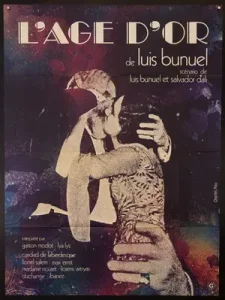L'Âge d'Or
(France, 1930, Luis Bunuel, 63 minutes)
Love in Chains: How Bunuel's 'L'Âge d'Or' (1930) Unleashed Surrealist Fury and Shocked a Nation!
In the revolutionary ferment of 1920s and early 1930s European art, Surrealism emerged as a defiant and provocative force, shattering bourgeois conventions and delving into the depths of the subconscious. Luis Buñuel, a Spanish filmmaker and one of the movement's most radical adherents, along with his collaborator Salvador Dalí, unleashed a cinematic "founding act" with Un Chien Andalou (1929). Following this notorious debut, Buñuel deepened his subversive vision with L'Âge d'Or (The Golden Age, 1930), a film that wasn't just experimental; it was a furious, relentless assault on every pillar of polite society – religion, family, patriotism, and bourgeois morality. Funded by the Vicomte de Noailles, this film represents a monumental moment in cinematic history, a pure, unadulterated expression of Surrealist ideology that aimed to shock, liberate, and utterly dismantle the established order, cementing its place as a legendary, controversial cult classic.
The film, loosely structured yet brimming with symbolic power, follows the passionate, but perpetually thwarted, love affair between a man (Gaston Modot) and a woman (Lya Lys). Their desperate attempts to consummate their desire are continually interrupted and violently suppressed by society's oppressive forces: the Church, the State, and the stifling conventions of the upper class. Buñuel weaves a dizzying tapestry of sacrilege, anti-clericalism, scatological humor, and startling imagery – from cows appearing in a bedroom to a character kicking a dog, and most famously, a scene depicting Christ's disciples emerging from an orgiastic castle (an overt reference to Marquis de Sade). L'Âge d'Or is a relentless bombardment of taboos, designed to provoke an emotional and intellectual revolt, tearing down societal hypocrisy with savage wit and unflinching visual audacity. Its confrontational style, deliberate anachronisms, and profound disdain for conventional morality make it a truly unique and incendiary cinematic experience.
Director: Luis Buñuel.
Cast: Gaston Modot as The Man, Lya Lys as The Woman, Max Ernst as Leader of the Bandits, Salvador Dalí (uncredited cameo).
Special Info/Trivia: L'Âge d'Or was funded by the wealthy Vicomte de Noailles, a patron of the arts. It sparked widespread outrage and violent protests from right-wing groups, leading to its ban in France for decades. The film's themes are a direct attack on religion, bourgeoisie, and patriotism, core tenets of Surrealist critique. Salvador Dalí was a co-writer in the early stages, though his involvement diminished. It is considered a cornerstone of Surrealist cinema and an essential work in Luis Buñuel's filmography. It was released just one year after Buñuel and Dalí's other groundbreaking short, Un Chien Andalou.

